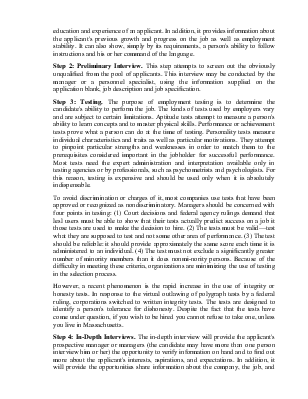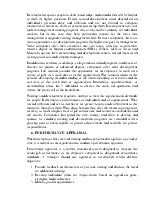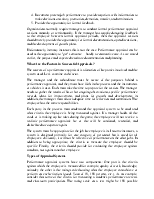
















STAFFING DEFINED
The staffing function can be viewed as consisting of a series of steps that managers perform to provide the organization with the right people in the right positions. The eight steps in the process are these:
1. Human resource planning. The purpose of human resource planning is to ensure that the personnel needs of the organization will be met. An analysis of the plans of the organization will determine what skills will be needed. Then management can review the present inventory of skills of the organization and develop a plan to provide the quantity and quality of personnel needed in the future.
2. Recruitment. After the human resource needs are determined, managers undertake recruitment to locate prospective employees. They may accomplish it through newspaper and professional journal advertisements, employment agencies, contacts at trade schools or colleges, and internal sources of the organization.
3. Selection. The selection process involves evaluating the candidates and choosing the one whose credentials match job requirements. The steps in the selection process may include completing an application blank, interviews, reference checks, and physical examination.
4. Induction and orientation. This step integrates the selected employee into the organization. Processes include organizational socialization with the work group and becoming acquainted with the organization's policies and rules.
5. Training and development. Both training and development are concerned with improving the employee's ability to contribute to organizational effectiveness. Training involves the improvement of employee skills. Development concerns the preparation of the employee for additional responsibility or advancement.
6. Performance appraisal. This step is one of appraising the employee's performance in relation to job standards and then providing feedback to the employee.
7. Employment decisions: rewards, transfers, promotions, demotions. The appraisal of performance results in management's making employment decisions, areas of which are monetary rewards, transfers, promotions, and demotions.
8. Separations. The dynamics of the staffing process involve both inflow and outflow of people. Managers are concerned with voluntary turnover, retirements, layoffs, and terminations.
Another element needs to be added to the staffing environment— compensation. Although it is not a step in the process, it is an ongoing element of the staffing function. It involves the determination of an employee's initial wages, changes to that through raises, and the accompanying benefits.
RESPONSIBILITY FOR THE STAFFING FUNCTION
The staffing functon of the organization, sometimes identified as personnel management or human resource management, is a part of every manager's job. Each individual manager performs each of these basic staffing activities. In small- to medium-sized organizations the individual manage, has most of the responsibility for the staffing function. As companies, expand operations and need more people, a decision usually is made to employ a specialist called a human resource manager or personnel manager to assume the more technical staffing matters. However, each manager still is responsible for the staffing activities in his or her own area, which requires that the personnel manager and departmental manager work together effectively.
1. HUMAN RESOURCE PLANNING
The overall human resource planning process for an organization involves forecasting the demand for and supply of personnel. There are three elements to the planning: forecasting the personnel requirements, comparing the requirements to the inventory of potential candidates within the organization, and developing specific plans for how many people to recruit (from outside) or whom to train (from inside).
v Human Resource Forecasting
Human resource forecasting attempts to predict the organization's future demands for people and for jobs. The forecasting process can be simple or complex, depending on the kind of organization, its size, and the length of time considered in the forecast.
In forecasting the personnel requirements of the organization, management needs to consider the strategic plans of the organization and the normal employee turnover. Strategic plans determine the direction for the company and its need for people. The plans will dictate how many people will be needed (increase or decrease) to staff the organization and what skills and abilities they will need. The types of decisions made in planning can have different impacts on the manpower requirements of the organization: A decision to create a new product or new division may mean an increase in the number of personnel and new positions, whereas plans to contract operations may lead to major workforce reductions. A strategy' calling for maintaining the status quo may result in a decision to hire new employees only when present employees leave the company.
v Human Resource Inventory
Уважаемый посетитель!
Чтобы распечатать файл, скачайте его (в формате Word).
Ссылка на скачивание - внизу страницы.